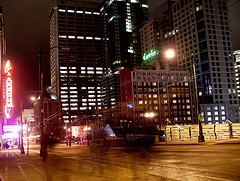This weekend, my in-laws came to town. Which was a very happy occasion.
 I handed over my two-year-old daughter (and four pages of instructions) to them while my husband and I fled to a hotel in downtown Seattle for two glorious nights. We drank martinis at the Mayflower Park Hotel (among other places, but those were the best), got to see the new Coen brothers movie, slept as late as we wanted, dropped into a yoga class and ate the yummiest – albeit smallest – steak of my life at the Spur Gastropub. Basically, we cruised around the city as if we were unencumbered 22-year-olds.
I handed over my two-year-old daughter (and four pages of instructions) to them while my husband and I fled to a hotel in downtown Seattle for two glorious nights. We drank martinis at the Mayflower Park Hotel (among other places, but those were the best), got to see the new Coen brothers movie, slept as late as we wanted, dropped into a yoga class and ate the yummiest – albeit smallest – steak of my life at the Spur Gastropub. Basically, we cruised around the city as if we were unencumbered 22-year-olds.
This was not the kind of vacation we usually take. Our leisure time is dominated by campsites, cross-country skis, pancake mix and road trips to Rocky Mountain trout streams – the kind of places that are most easily driven to.
No doubt, the absence of my kid contributed mightily to the unfamiliar state of relaxation that I haven’t really experienced since she was born. But as I awoke and had to choose only whether to walk 7 blocks to the waterfront for eggs benedict or 7 blocks up Capitol Hill for some uttanasana, I also realized how much I loved the vacation from my car.
So I got curious about what research had been done on car-free travel, and how it enhances the vacation experience. I’d hoped Google would spit out a Chamber of Commerce study that found car-free visitors were so much happier they spent 27 percent more money, but this kind of empirical data seems hard to come by. (If anyone out there has stats on car-free tourism or wants to add to Sightline’s running list of the best car-free vacations, please share!)
Here’s what I can say: there are obvious benefits to carless leisure, and savvy tourism destinations from Alpine ski resorts to California beach towns are taking smart steps to encourage car-free travel and build strong brands around it. So why aren’t more cities doing it?
The annual Green Travel Forecast survey asks tens of thousands of vacationers planning to visit US cities how they intend to get around on their trip. Cost and convenience were at the top of the list for a growing number of car-free travelers in 2010:
- 52 percent of visitors said they planned to use public transportation on their visit (a figure that’s increased over the last four years).
- 49 percent said it would be less expensive than taking taxis or a rental car.
- 46 percent liked not having to worry about a parking.
- 36 percent didn’t want to drive around in an unfamiliar city.
- 51 percent said that the availability of public transit influenced their decision on where to visit.
I would add being able to drink a second cocktail and getting to experience a city on a more intimate scale to that list of advantages. But dense urban areas aren’t the only places where car-free tourists can benefit.
Santa Barbara Car Free, which was established in 1998 and has won numerous awards, has convinced dozens of hotels, restaurants and tour operators to offer serious discounts to car-free travelers who arrive via Amtrak, bus or bicycle. You can get free desserts and appetizers, a pair of walking socks and discounts on wine tours, sailing cruises, whale watching trips, kayak adventures and transportation services. The organization also offers good maps of the city with bike and bus routes, and walking tours of beaches, missions and waterfront sights.
And in a more global experiment, two dozen resort communities across the Alps have joined the “Alpine Pearls” network. To be included, a visitor has to be able to arrive by bus or train and be able to easily enjoy a completely car-free holiday. At the various destinations, one can get around by foot, free buses, boats, electric bikes, horse-drawn carriage, showshoes, ski lifts or llamas. And the communities – which span six countries – have invested in human-scale infrastructure with networked hiking trails, pedestrian-only areas or car free valleys.
Closer to home, I found an advertisement for these bike-friendly Portland hotels that offer packages to carless travelers. The BC Car-Free outdoor guidebook offers offers a wealth of online information and ways to explore southwest British Columbia. And we’ve done our fair share of blogposts on car-free hiking options.
But are there more systemic efforts afoot in the Northwest to encourage car-free travel and give non-motorized tourists a more seamless experience? (I’m sure there are, but the fact that not many popped up in basic online searches that the average tourist might use makes me think they may need better marketing.)
And, more importantly, my grandparental babysitting bank has is likely to be empty until next year. So who has more suggestions for car-free vacation itineraries, with or without toddlers in tow?
Downtown Seattle photo courtesy of flickr user rutlo via a Creative Commons license.

Comments are closed.